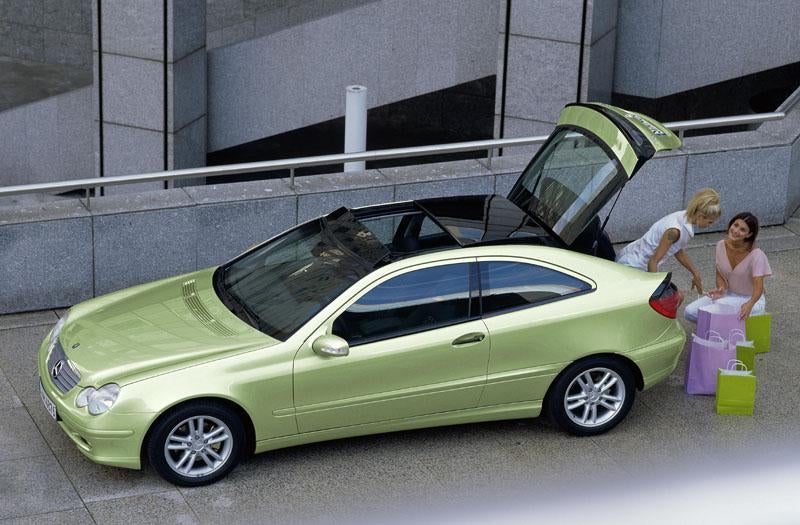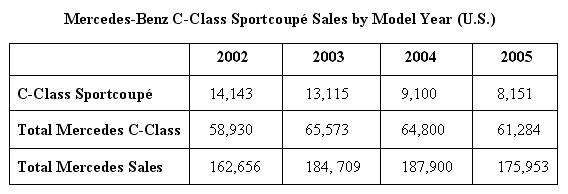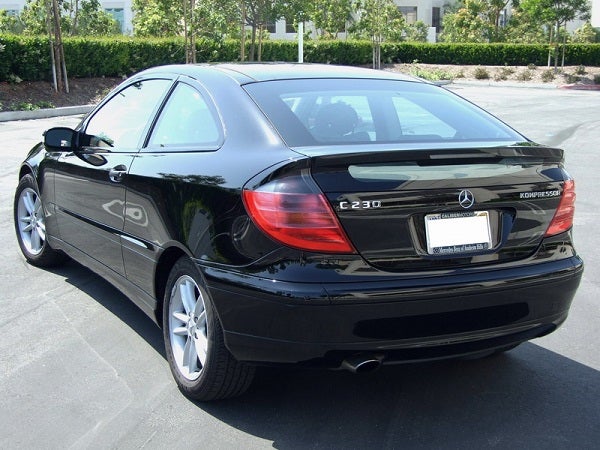 "Jagvar" (Jagvar)
"Jagvar" (Jagvar)
03/25/2014 at 12:59 • Filed to: Features
 4
4
 6
6
 "Jagvar" (Jagvar)
"Jagvar" (Jagvar)
03/25/2014 at 12:59 • Filed to: Features |  4 4
|  6 6 |

In the late 1990s, Mercedes-Benz, known around the world as the producer of bespoke luxury cars, began to consider a move down-market in North America. The median age of American Mercedes-Benz owners at that time was 52, and the company hoped to attract younger buyers with a more affordable car. Its smallest passenger vehicle, the compact A-Class, was introduced to Europe in 1997 to mixed acclaim, but wasn't deemed suitable for the U.S. market.
In the 2002 model year, Mercedes-Benz USA finally seized the opportunity to move down-market with a hatchback version of its popular C-Class. Dubbed the Sportcoupé, the car was simultaneously released in the North American, European, and Asian markets. The base price in the United States was $24,950, and unlike other Mercedes-Benz models, a leather interior was not standard.
The Sportcoupé was offered with 10 different engines in its home country of Germany, from a 1.8L R4 (found in the C160), to a 3.2L supercharged V6 (found in the C32 AMG). The diesel-powered C220 CDI Sportcoupé was the volume leader in Europe, with a 30 percent market share in Germany alone. In the United States, however, only two Sportcoupé models were offered: the C230 and the C320, powered by a 4-cylinder and 6-cylinder gasoline engine, respectively.
Mercedes-Benz's initial U.S. sales target for the Sportcoupé was 16,000 a year. While the Sportcoupé was more popular in the U.S. than !!!error: Indecipherable SUB-paragraph formatting!!! , Mercedes-Benz still never reached its target sales numbers. By the car's final year in the U.S. market, Mercedes-Benz was barely achieving half of its annual target.
!!! UNKNOWN CONTENT TYPE !!!
Below is a tally of Sportcoupé sales in the U.S. for each model year. Total C-Class sales and overall Mercedes-Benz sales are included for comparison.

Mercedes-Benz came closest to reaching its annual sales target in the car's first year, but even then, Mercedes-Benz sold almost 2,000 fewer models than anticipated. The introduction of the V6-powered C320 Sportcoupé to the U.S. in 2003 did little to boost sales. Once the initial hype died down, Americans quickly turned away from the Sportcoupé. U.S. sales declined every year that the car was available in North America.
Marketing
The word "Sportcoupé" was adopted by Mercedes-Benz with the U.S. market in mind. Words like "hatchback" and "compact" had proved unpopular with American consumers, so Mercedes-Benz instead marketed its hatchback as a "sporting coupé." The car sold better in the U.S. than the BMW 318ti (which itself had been marketed as a "compact"). While BMW sold only 19,890 units of its 318ti in the U.S., Mercedes-Benz sold 44,509 Sportcoupés.
With the Sportcoupé, Mercedes-Benz aimed for an audience very different from the traditional Mercedes-Benz customer. The typical Mercedes-Benz buyer is middle-aged (average: 52), well-off (median household income of $159,000), married (81 percent), and male (64 percent). With the Sportcoupé, Mercedes-Benz targeted young drivers who earn an average of $75,000 a year. About half of Sportcoupé buyers were expected to be female.
For all of the work that Mercedes-Benz put into developing its hatchback, it did very little to advertise it in the U.S. market. American dealers blamed Sportcoupé overstock on "a lack of advertising and marketing support."
What Mercedes-Benz lacked in U.S. marketing, it made up for with cash incentives. The company paid dealers $4,000 for each Sportcoupé bought in March 2003 for use as a demo or service-department loaner. Mercedes-Benz also offered consumers a $1,500 retail incentive in 2003.
U.S. Failure

Despite the Sportcoupé's failure in the U.S. market, Mercedes-Benz did learn from some of the mistakes BMW made with the 318ti. The body of the 3 Series Compact had been identical to the 3 Series sedan from the nose to the C-pillar. BMW had designed the car this way to reduce costs, but the result was a car with an abrupt, squat rear end. Mercedes-Benz, on the other hand, designed the Sportcoupé independently from other C-Class models for aesthetic purposes. The Sportcoupé didn't share a single body panel with the C-Class sedan.
Price was a problem for the Sportcoupé, as it had been with the BMW. Even though its base price was under $25,000, that price rose considerably once options were added, and a fully-loaded Sportcoupé could sell for more than $32,000. The base price of a Mercedes-Benz C240 sedan, meanwhile, was $30,595. American buyers interested in buying a low-end Mercedes-Benz more often bought the C-Class sedan, since it was so close in price. Non-luxury buyers were more interested in cars like the Acura RSX and even the Mitsubishi Eclipse, which were faster and less expensive than the Sportcoupé.
Ultimately, Mercedes-Benz pulled the C-Class Sportcoupé from the U.S. at the end of 2005 for two reasons. Declining sales obviously made the car a financial drain. But more importantly, Mercedes-Benz leadership feared the damage that the failing non-luxury car could do to the brand's prestige. In the automotive world, there is always a conflict between boosting sales and protecting a brand's exclusivity, and the Sportcoupé was the tragic embodiment of that challenge.
 Sn210
> Jagvar
Sn210
> Jagvar
03/25/2014 at 13:08 |
|
Your expectations can't be too high if you offer a car in celery green...
Again I'll pose the question: what's the future classic outlook on these?
I'd say it's much less than the 318. I find the bimmer to be quirkier and I think the brand has a different type if fanbase that would still accept it in 15 more years. There just isn't much about the sport-coupe that I find appealing, other than it's low production numbers.
 Jagvar
> Sn210
Jagvar
> Sn210
03/25/2014 at 13:19 |
|
The two AMG models (C30 CDI AMG and C32 AMG) may have future classic potential, but they weren't offered on our shores. I think the U.S. models will simply be lost to time.
 Lorinserc230
> Jagvar
Lorinserc230
> Jagvar
03/25/2014 at 13:21 |
|
I love mine. Though having the 6-sp manual + some aftermarket modifications really makes it a lot more fun to drive. I love the utility though too, I moved in and out of college with this car. Plus with the back seats down and the glass roof, it makes an ideal car for "stargazing"
 ixismore
> Lorinserc230
ixismore
> Lorinserc230
03/25/2014 at 17:58 |
|
I feel like with a manual it'd be better... What mods? We have a C230 btw.
 ixismore
> Jagvar
ixismore
> Jagvar
03/25/2014 at 18:07 |
|
I'm just gonna repost this from the 318ti thread, my family has a C230 (2.3).
Bads:
The panoramic roof broke and will cost thousands to repair, the suspension rolls yet isn't really comfortable, the interior is early 2000's MB (iffy quality and such), the steering is quite numb and veryyyyyyy slow (awful at slalom, not enough turning/have to move hands), the brakes suck in when it thinks you're panic stopping at random times when driving somewhat hard (BAC), the stability control is on a hell bent mission to stop you in the opposing lane of traffic seemingly every time you try to turn left with more than 30% throttle (turning it off still leaves TCS on as far as I can tell... And no this doesn't mean I'm flooring 90 degree turns every opportunity, but if there's a pebble or two expect 2-3 seconds of coasting at 5 mph) while it reconsiders just what it was designed to do, and the engine sounds god awful and clattery with the windows down forcing you to use the crappy automatic climate control that never really has worked (oh ya, ours broke as well. Pretty much all the flappers deep in the bowels of the dash are broken. Great).
The Goods?
Looks cool, sophisticated, what have you (but the headlights plastic is crap quality and fades needing biyearly attention), it's quite reliable, only needing a timing chain tensioner as the one unexpected repair, it gets an honest to god 30-32 mpg on the highway (20ish in city), the car has a good bit of power everywhere with a supercharger and ~192 hp, and with rwd and not weighing an awful lot, I like to think of it as a 200-300 lb heavier RWD Golf GTI! But it isn't... It just isn't.
Now to Lorinserc230: I feel short of the roof, engine note/clatter, and build quality, mods could fix it. It seriously looks cool with nice wheels, a real TCS/ESP disable might be a flash away (seriously way too frustrating), and a manual could solve most of its frustrating problems.
 Lorinserc230
> ixismore
Lorinserc230
> ixismore
03/26/2014 at 19:20 |
|
Pretty extensive: new suspension, brembos, upgraded supercharger, ecu retune, new exhaust, wheels, tires, plus cosmetic additions. Bought it as-is so honestly cant speak to what a stock one is like to drive, but I definitely like the concept.